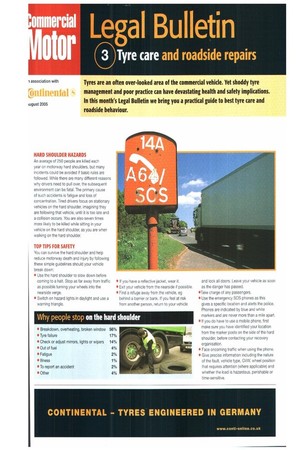HARD SHOULDER HAZARDS
Page 23

If you've noticed an error in this article please click here to report it so we can fix it.
An average of 250 people are killed each year on motorway hard shoulders, but many incidents could be avoided if basic rules are followed. While there are many different reasons why drivers need to pull over, the subsequent environment can be fatal. The primary cause of such accidents is fatigue and loss of concentration. Tired drivers focus on stationary vehicles on the hard shoulder, imagining they are following that vehicle, until it is too late and a collision occurs. You are also seven times more likely to be killed while sitting in your vehicle on the hard shoulder, as you are when walking on the hard shoulder.
TOP TIPS FOR SAFETY
You can survive the hard shoulder and help reduce motorway death and injury by following these simple guidelines should your vehicle break down: • Use the hard shoulder to slow down before corning to a halt. Stop as far away from traffic as possible turning your wheels into the nearside verge.
• Switch on hazard lights in daylight and use a warning triangle. • If you have a reflective jacket, wear it.
• Exit your vehicle from the nearside if possible.
• Find a refuge away from the vehicle, eg behind a barrier or bank. If you feel at risk from another person, return to your vehicle and lock all doors. Leave your vehicle as soon as the danger has passed.
• Take charge of any passengers.
• Use the emergency SOS phones as this gives a specific location and alerts the police. Phones are indicated by blue and white markers and are never more than a mile apart.
• If you do have to use a mobile phone, first make sure you have identified your location from the marker posts on the side of the hard shoulder, before contacting your recovery organisation.
• Face oncoming traffic when using the phone.
• Give precise information including the nature of the fault, vehicle type, GVW, wheel position that requires attention (where applicable) and whether the load is hazardous, perishable or time-sensitive.






























































































































































































